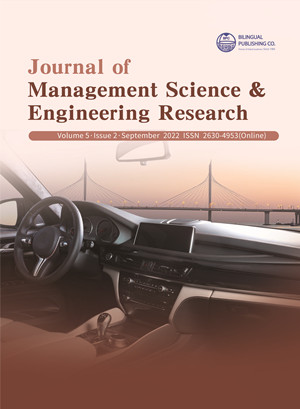-
5450
-
917
-
416
-
397
-
391
Research on the Comparison between the Different Policies by Service Level and Inventory Level Performance of Auto Parts in N.A.C.C. (North Automobile Components Company)
DOI:
https://doi.org/10.30564/jmser.v5i2.4593Abstract
As after sales services become more and more popular, particularly preventive or corrective maintenance, the intervention and repair of the customer’s goods in a timely and efficient manner ensure customer satisfaction and contribute to the establishment of brand image in the market of the suppliers. The availability and quality of spare parts are key elements of this strategy while ensuring minimal management costs. The reuse of spare parts retrieved from customer systems is a growing maintenance strategy practice which impacts the traditional spare parts supply chain. This reuse is primarily driven by extending the economic life of goods, initially regarded as waste and therefore without added value, by transforming them into valuable spare parts that can be reused; secondly, for environmental or regulatory reasons, demanding responsibility for the treatment of products at the end of their life; and thirdly, to improve the availability of parts for maintenance, especially parts that the organization can no longer purchase or that are impacted by other issues. It also involves the analysis of their condition and their eventual return to working order as they are retrieved from the customer’s systems in a defective condition. In this paper, we will identify and classify the different customers and spare parts by estimating the critical level of rationing policy based on forecasts, identify the thresholds of inventory management policies, and finally, compare the different policies by service level and inventory level performance for the N.A.C.C. company.Keywords:
Classification; Policies; Auto parts; Forecast; Performance analysis; ComparisonReferences
[1] Boylan, J.E., Syntetos, A.A., 2007. The accuracy of a Modified Croston procedure. International Journal of Production Economics. 107(2), 511-517. DOI: https://doi.org/10.1016/j.ijpe.2006.10.005
[2] Teunter, R.H., Duncan, L., 2009. Forecasting intermittent demand: a comparative study. Journal of the Operational Research Society. 60(3), 321-329. DOI: https://doi.org/10.1057/Palgrave.Jors.2602569
[3] Chiou, H.K., Tzeng, G.H., Cheng, C.K., 2004. Grey prediction model for forecasting the planning material of equipment auto parts in the navy of Taiwan. Proceedings world automation congress. 17, 315- 320.
[4] Zhang, H., 2019. Improved transudative support vector machine for a small labeled set-in motor imagery-based brain-computer interface. pp. 2-3.
[5] Gutierrez, R.S., Solis, A.O., Mukhopadhyay, S., 2008. Lumpy demand forecasting using neural networks. International Journal of Production Economics. 111(2), 409-420. DOI: https://doi.org/10.1016/j.ijpe.2007.01.007
[6] Tang, Zh.J., Long, Y.L., 2012. Research on the method of acquiring individual demand based on kano model. pp. 127-131.
[7] Chen, X., Cai, D., 2011. Large scale spectral clustering with landmark-based representation. AAAI Conference on Artificial Intelligence. pp. 313-318.
[8] Levi, R., Shi, C., 2005. Approximation algorithms for the stochastic lot-sizing problem with order lead times. https://www.ResearchGate.Net/publication/260162679. pp. 14-24.
[9] Valero, M., Averkin, R.G., Fernandez-Lamo, I., et al., 2017. Mechanisms for selective single-cell reactivation during offline sharp-wave ripples and their distortion by fast ripples. Neuron, 94(6). pp. 1234-1247. DOI: https://doi.org/10.1016/j.neuron.2017.05.032
[10] Canyakmaz, C., Özekici, S., Karaesmen, F., 2019. An inventory model where customer demand is dependent on a stochastic price process. International Journal of Production Economics, 212, 139-152. DOI: https://doi.org/10.1016/j.ijpe.2019.01.039
[11] Van Nguyen, T., Zhou, L., Chong, A.Y.L., et al., 2020. Predicting customer demand for remanufactured products: a data-mining approach. European Journal of Operational Research. 281(3), 543-558. DOI: https://doi.org/10.1016/j.ejor.2019.08.015
[12] Zhang, W.X., Xiao, R.B., Lin, W.G., 2020. Review data driven customer need model research based on product performance lexicon. China Mechanical Engineering, 31(15), 1866-1876. DOI: 10.3969/j.issn.1004-132X.2020.15.014
[13] Bontempi, G., De Stefani, J., 2017. Factor-based framework for multivariate and multi-step-ahead forecasting of large-scale time series. Frontiers in Big Data. pp. 14-27.




 Sory Ibrahima Cisse
Sory Ibrahima Cisse





